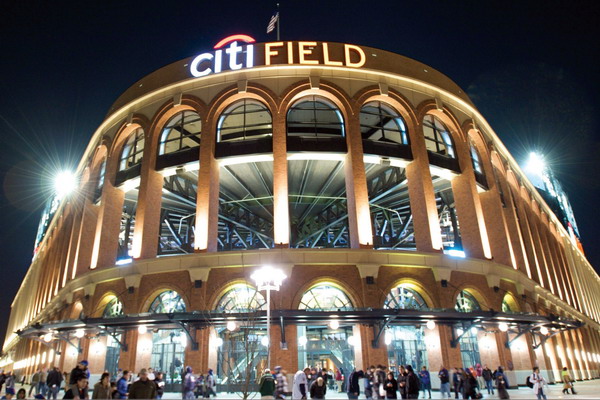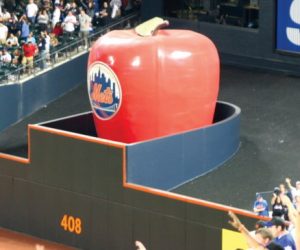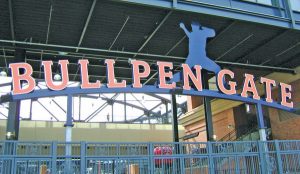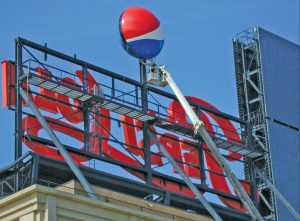Electric Signs
Recreating America’s Pastime
Published
15 years agoon

Christopher Glanzman is a graphic designer for Broadway National Signs (Ronkonkoma, NY).
In early 2008, the joint-venture alliance of Hunt/Bovis Lend Lease, the construction manager for the Queens Ballpark Co. LLC, awarded Broadway National Signs the task of supplying the New York Mets with interior and exterior signage for Citi Field, the new ballpark the team opened for the 2009 season. The team decided the new ballpark’s design should pay tribute to the old Ebbets Field, the home of the then-Brooklyn Dodgers until 1957, and to Jackie Robinson himself, whose courage and performance as Major League Baseball’s first African-American player gave him iconic status in baseball history.
Our mission was clear: combine the luxuries and comforts of a modern-day ballpark with the aesthetics and nostalgia of a bygone era warmly remembered. Creating the vision of an iconic ballpark required exacting detail from our talented staff. With Hunt-Bovis already undertaking the building’s construction, and Two Twelve Assoc. devising the signs’ design and layout, we prepared our 40,000-sq.-ft. shop for the inevitable demands such a high-profile project would entail.
Building Citi’s identity
Once Citigroup secured the naming rights and unveiled the Citi Field logo, the project kicked into high gear. While Two Twelve finalized the interior-sign scheme, we started building the exterior program.
Patrick Dooley, Broadway National’s vice president and general manager, stated, These large signs were going to be the face of the ballpark and, in turn, its identity. Getting this right was of the utmost importance.”
AdvertisementAfter many prototypes, sample submissions and color-combination selections that satisfied all interested parties, another stipulation arose. Eric Saretsky, vice president of Queens Ballpark, asked us to meet the team’s demand for a “green” ballpark and use LEDs. Based on an average letter height of 12 ft. 3 in. tall, using LEDs would create an average annual savings of 110,000kW. In NYC, that equates to a savings of more than $20,000.
Diane Kopec, PMP, Broadway’s senior project manager, led the search for a suitably luminous product. We decided to use 9,700 linear ft. of SloanLED’s V Series, white and red LEDs and 317 of its Mod 60 power supplies. We covered the letters with Spartech’s Crylex high-impact acrylic and 3M first-surface vinyl with diffusers. We developed a 12-in.-deep, “H”-type letter system that maximizes illumination while providing a cavity that enables readily accessible power supplies. We specified custom red, orange and white Matthews paint to decorate all exposed surfaces.
Using every square inch of capacity, we simultaneously fabricated seven sets of Citi Field channel letters. To meet the team’s public-relations demands, we installed the letters in a specific order. First, we installed the 15-ft.-tall letters that reside atop the 195-ft.-wide, main scoreboards. Next, we situated the other, 15-ft.-tall letter set that faces the Whitestone Parkway. Then, we mounted 8-ft.-tall channel letters at the entrance to the Jackie Robinson Rotunda. We bolted these letters to the brick façade and mounted them using a “shoe to shoe” application.
Finally, we installed the four, 12-ft.-tall letter sets on the ballpark’s exterior wall. We mounted two to the light stanchions, and another set was placed at the administrative entrance on 126th St., using pre-fabricated supports. The final set of 12-ft. letters was installed at the North Dock location facing Northern Blvd. Pre-fitting the letters in our facility allowed for smooth, efficient installation.
Mounting the letters above the scoreboard proved to be a significant challenge. Initially, the letter sets would follow the scoreboard’s curvature, but doing so hindered the effectiveness of Citigroup’s branding. So, Broadway created a steel frame that could be incorporated within the letter structure to support the signs without altering the design intent.
Because the signs measure more than 100 ft. long, this task became monumental. Kopec, plant foreman Kevin Schuessler and AutoCAD guru A.J. DeSantis collaborated with WSP Cantor Seinuk, a structural-engineering firm, to create a 3-D prototype. Using a 6 x 6 x ¼-in., steel-tube girding system, with attachment points that match the existing support structure and the fabricated letters, we installed the sign. With the steel supports in place, we installed the letters with assistance from Rick Bernardo from Bay Crane (Hicksville, NY) and Tom Cocchiere from Clear Channel Outdoor’s NYC office.
AdvertisementThe Apple’s new core
Broadway National also managed fabrication of the Mets’ Home Run Apple, which measures 16 ft.-tall and 18 ft. in diameter and emerges from a concealed area. It features SloanLED FlexiBrite rope lights that surround the 8-ft.-tall, digitally printed Mets logo that’s mounted to the Apple’s face and light up every time the home team hits a homer. The Apple had been a longstanding Shea icon, and the team wanted to keep the tradition.
Uni-Systems (Minneapolis) designed the Apple. Uni-Systems’ project engineer, Mark Silvera, worked closely with Kopec to manage scope requirements and on-time fabrication. Oversized tractor-trailers hauled the Apple to Citi Field in three sections along with the Apple’s hydraulic support structure.
Prior to the Apple’s installation, it required 1,700 ft. of Beldon 3082F wiring from its home “garage” in centerfield to the control room at the ballpark’s Excelsior level. ASR (Plainview, NY) did a remarkable job with the wiring; Joe Leo, ASR’s project foreman, showed remarkable professionalism on the job.
To help route the wiring, ASR installed it within the cable tray on the plaza level. The system uses a dual, remote-control system that operates the Apple’s hydraulics either from the control room or from the Apple’s garage. This represents a significant upgrade from the relatively limited electronic capabilities at Shea. The Apple weights slightly more than three tons, but we engineered the hydraulic system to support approximately
4.5 tons. The surplus capacity allows the hydraulic system to lift the Apple quickly and smoothly.
Get your tickets here
Advertisement
To welcome fans to specific ballpark areas and point them to the ticket window, we fabricated sets of 42-in.-tall channel letters and mounted them to steel arcs. Each letter features an illuminated face with ¼-in.-thick, solid-metal outline molding. Every color needed to match, and, in some situations, we had to find creative solutions to meet the client’s needs.
The team wanted the signs’ vinyl faces to gleam with the same “warm
bronze” color in the daytime as when they’re illuminated at night. To make matters more difficult, we found no material that matched this particular color. Digital-printing options provided too much day/night contrast.
Ultimately, we layered 3M’s Scotchcal 3630-129 bronze, translucent vinyl on orange Plexiglas® 2119 acrylic, and then backed it with a 30%, light-diffusing vinyl. The result
provided the desired effect – an almost perfect day/night match.
The gate signage features large silhouettes of former Mets players, which were built and mounted to the entry arc. Each profile comprises a steel skeleton that we then clad in aluminum in the shape of the player profile. Towering above the illuminated
entrance and ticket-window signs, silhouettes of Tom Seaver, Endy Chavez and Ron Swoboda bridge the connections that Mets fans associate with Shea Ballpark.
The flavor of Pepsi
After having seen how Broadway National handled the large Citi Field signs, another major sponsor, Pepsi Cola, approached us to design, fabricate and install a sign
that would prove to be the ballpark’s biggest and brightest. Pepsi’s classic sign above its Long Island City bottling plant loomed as a local icon. Management for the soft-drink giant wanted to carry its name to the ballpark by recreating this sign on a larger scale.
The 40 x 90 ft. sign had never been part of the original design intent, so Broadway National built a custom, steel structure that enabled us to piece the sign together in our shop, and then install the structure onsite. While our team cut and fabricated
letter sections, we filled the back of our shop with the supporting steel frame. We built each letter and mounted it to the frame to make sure that everything would fit when installed. We carefully laid out each letter to minimize seams on the faces. We produced most of the smaller, 10-ft.-tall letters in one piece.
After we applied 3M’s red Scotchcal vinyl to the faces, we painted the letters with Matthews acrylic-polyurethane paint. SloanLED provided a template for its V Series LEDs, which we referenced to install hundreds of rows of modules. For the 15-ft.-diameter, fiberglass sphere that’s integral to the new Pepsi logo, we internally illuminated it from below using six Holophane 400W, mercury-vapor, HID fixtures.
It was time to pack the sign components on tractor trailers and secure the appropriate permits for oversized-load transport and street closings to ship them to the ballpark for installation. We connected the letters and hooked them up to the power system Hunt/Bovis provided. Thanks to strong project management and years of experience, the installation progressed without a hitch.
Meet the Mets (and find your seat)
Once we d installed and tested the ballpark s large, electric signs, Broadway National and the New York Mets were proud and confident with the impression the signage would make on generations of Mets fans, but this was only the beginning. Broadway National worked around the clock to create and install approximately 2,200 interior, ballpark signs before Opening Day.
We all buckled down and worked every day to create an interior environment that equally reflected the work we had put together for the exterior signs. Althought these won t be the ballpark s most prominent signs, they required significant time and energy to produce accurately.
Some of these secondary signs include:
- More than 370 section markers the comprise aluminum that s painted, masked and hung with bolts;
- Approximately 60 suite plaquesthat are painted and screenprinted with raised, silver lettering;
- Overhead-level IDs that guide fans walking down ramps, out of elevator areas and around concourses;
- An aluminum structure cald with a digital print at each stairwell landing that outlines the sessions accessible at that level; and
- An additional three sets of 11-ft.-long channel letters attached to Citi Field promenade-level roof, which are visible to planes flying overhead.
"Under tight time limitations, our project managers, mechanics, electricians, designers and installers all came together and got the work done," William Paparella, Broadway National s CEO and president, said.
On Monday, April 13, the New York Mets welcomed their fans to a new season and a new, completed ballpark. From the Jackie Robinson Rotunda to the Pepsi Porch, Broadway National proudly serves the interior and exterior signage provider for the Mets and Citi Field.

SPONSORED VIDEO
Introducing the Sign Industry Podcast
The Sign Industry Podcast is a platform for every sign person out there — from the old-timers who bent neon and hand-lettered boats to those venturing into new technologies — we want to get their stories out for everyone to hear. Come join us and listen to stories, learn tricks or techniques, and get insights of what’s to come. We are the world’s second oldest profession. The folks who started the world’s oldest profession needed a sign.
You may like

Michigan Residents Make Parodies of Viral Detroit City Sign

What Makes the Perfect Sign Business Partnership

Marketing Signs to Schools, Tradeshow and Quote Follow-up Make May’s List
Subscribe

Bulletins
Get the most important news and business ideas from Signs of the Times magazine's news bulletin.
Most Popular
-

 Photo Gallery2 weeks ago
Photo Gallery2 weeks ago30 Snapshots of the 2024 ISA Sign Expo
-

 Ask Signs of the Times2 weeks ago
Ask Signs of the Times2 weeks agoWhy Are Signs from Canva so Overloaded and Similar?
-

 Paula Fargo1 week ago
Paula Fargo1 week ago5 Reasons to Sell a Sign Company Plus 6 Options
-

 Real Deal5 days ago
Real Deal5 days agoA Woman Sign Company Owner Confronts a Sexist Wholesaler
-

 Photo Gallery1 week ago
Photo Gallery1 week ago21 Larry Albright Plasma Globes, Crackle Tubes and More
-

 Women in Signs2 weeks ago
Women in Signs2 weeks ago2024 Women in Signs: Brandi Pulliam Blanton
-

 Women in Signs2 weeks ago
Women in Signs2 weeks ago2024 Women in Signs: Alicia Brothers
-

 Projects5 days ago
Projects5 days agoGraphics Turn an Eyesore Cooler Into a Showpiece Promo in Historic Plaza















